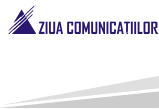COMMUNICATIONS DAY 2008
12 th Edition, 8 th of May 2008, Crowne Plaza, Bucharest
A landmark in the promotion and support of a high-priority industry in Romania, the event showcases the benefits of competitiveness in a dynamic sector and a high potential market, potential which needs to be developed after the European Union accession.
2008 Trends
-
Ubiquitous networks change business patterns and represent challenges for traditional operators, the socio-economical value of mobile communication and revolutionizing digital content in areas such as: mobile advertising, financial services, social networks.
-
2008 the WiMAX year. Barriers still in place: availability of the spectrum, competition of cellular standards, recovering the investment. Still, a large number of mobile operators have already chosen WiMAX as the access technology, with a viable business pattern. 2008 combines the fast pace of development for access terminals and backhaul technology with an increased band request, pointing to the fact that 2008 can become the year of large-scale adoption of WiMAX.
-
The inclusion of standards is encouraged. For ex.: WiMAX part of LTE and not a competing standard.
-
Mobile TV is still a fragmented technology, with business patterns based on unjustified content costs. However, the EC has approved the HVB-H standard for Europe, and media events in 2008 (the Beijing Olympics and Euro 2008) supply opportunities for adopting Mobile TV.
- Producers create new concepts of personalization. Ex: LG “Yuosability”.
-
Adopting simplified standards. Currently there are 30-40 operating systems for mobile terminals, which will be reduced to 4-5.
-
In the long run, efficient mobile operators will also cover the market for fixed telecommunication services.
-
LTE reduces costs by reusing cells, simplifying networks versus UMTS and eliminating support for commuting circuits (fully IP).
-
HSPA introduced by 250 vendors in 400 products, ensures 40Mb/s downlink and will reach 100Mb/s with the LTE development.
-
The size of cells is reduced at Femto level (indoor).
-
A NSN study evaluated the degree of usage for communication systems at national level and reveals the fact that even the 16 most advanced countries connectivity-wise use, on average, 50% of the potential of installed networks (70% of the economic potential in USA, 68% in Sweden and Japan and 48% in Korea!).
- The confrontation of networks is moved from 3G vs. WiMAX to WiMAX vs. LTE with the perspective of HSDPA (20% of networks) -> LTE (2009) + WiMAX (2007).
- LTE will be 4G and incorporate WiMAX. WiMAX is recommended for expanding current networks up to 20%, but inadequate for new networks.
- Suppliers of LTE semiconductors stay confidential, and Intel stays focused on WiMAX
|





